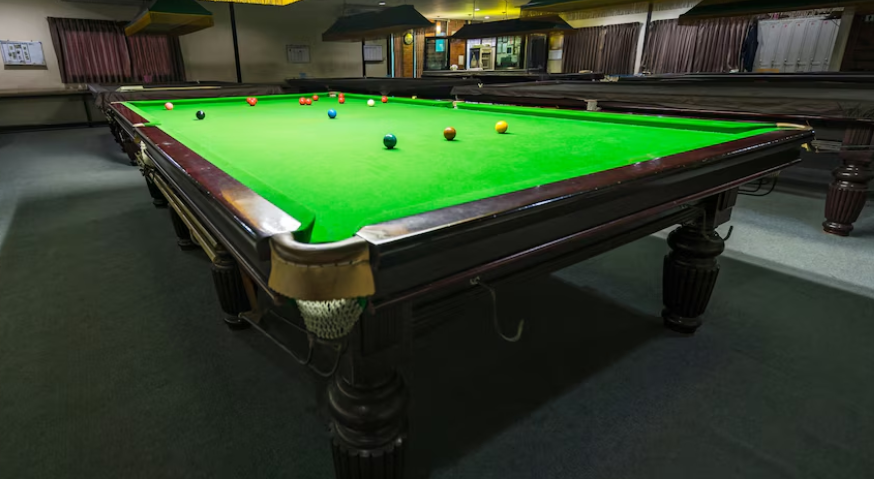Pool tables are a great addition to any home or recreational space, providing hours of entertainment. However, regular use can lead to wear and tear, requiring maintenance and repairs. Some issues, such as felt damage, loose rails, or an uneven surface, can be fixed without professional help. This guide covers common pool table repairs you can do yourself to keep your table in excellent condition.

Diagnosing Common Pool Table Problems
Before starting any repair, identify the issue affecting your pool table. Here are some common problems:
- Torn or worn-out felt
- Loose or damaged rails
- Unleveled playing surface
- Loose pockets
- Structural issues like cracked legs or frame
Each of these issues has a DIY solution that can help restore your table’s performance.
Replacing the Pool Table Felt
The felt is one of the most crucial components of a pool table. Over time, it can wear out, tear, or develop uneven spots that affect gameplay.
Steps to Replace the Felt
- Remove the Rails and Pockets – Unscrew the rails and carefully detach the pockets.
- Remove the Old Felt – Pull out the staples securing the felt and carefully remove it.
- Clean the Surface – Wipe down the slate to remove dust and debris.
- Attach the New Felt – Lay the new felt evenly over the slate, ensuring there are no wrinkles.
- Secure the Felt – Use a staple gun to attach the felt, stretching it tightly to avoid sagging.
- Reinstall Rails and Pockets – Once the felt is in place, reassemble the table.
Replacing the felt can improve the playing experience and restore the look of your table.
Fixing Loose Rails
Loose rails can affect ball rebound and overall gameplay. Tightening them ensures a consistent response.
How to Fix Loose Rails
- Identify Loose Rails – Check all the rails for movement.
- Tighten Bolts – Use a wrench to secure the rail bolts underneath the table.
- Check for Gaps – If there are gaps, insert rubber shims to create a snug fit.
- Test the Rails – Bounce a ball off the rails to ensure they are secure.
Regular maintenance of rails prevents inconsistent ball movement and prolongs the table’s life.
Leveling Your Pool Table
An uneven table can make playing frustrating. If balls roll unexpectedly, it’s time to level your table.
Steps to Level a Pool Table
- Use a Leveling Tool – Place a carpenter’s level on the playing surface.
- Adjust the Legs – Many tables have adjustable leg levelers. Turn them to raise or lower the table.
- Use Shims – If the table lacks adjustable legs, insert wooden or rubber shims beneath them.
- Test with a Ball – Roll a ball in different directions to confirm even leveling.
Proper leveling ensures fair play and prevents unnecessary wear on the felt.
Repairing Loose Pockets
Loose pockets can lead to missed shots or falling balls. Fixing them is a simple process.
How to Secure Pool Table Pockets
- Check Pocket Screws – Tighten any loose screws holding the pockets in place.
- Replace Worn-Out Nets – If the netting is damaged, replace it with a new one.
- Use Stronger Fasteners – If screws are stripped, replace them with slightly larger ones for a secure fit.
- Test with Balls – Drop a ball into each pocket to ensure stability.
Well-secured pockets enhance the overall gaming experience and table durability.
Fixing Structural Issues
Cracks or wobbly legs can compromise your pool table’s stability. Address these issues promptly to avoid further damage.
How to Repair Table Legs and Frame
- Identify Weak Points – Check for cracks or loose joints.
- Use Wood Glue or Screws – Apply wood glue for minor cracks or reinforce joints with screws.
- Replace Broken Parts – If a leg is severely damaged, consider replacing it.
- Check for Stability – After repairs, test by gently rocking the table.
A solid frame ensures long-lasting gameplay and prevents further structural issues.
Maintaining Your Pool Table for Longevity
Regular maintenance prevents major repairs and extends the life of your pool table.
Essential Pool Table Maintenance Tips
- Clean the Felt Regularly – Use a soft brush or vacuum to remove dust and chalk residue.
- Cover the Table – Protect the surface when not in use to prevent dust accumulation.
- Keep Liquids Away – Avoid spills that can stain or warp the table.
- Check for Loose Parts – Regularly inspect rails, pockets, and legs for stability.
Consistent maintenance reduces the need for frequent repairs and ensures optimal performance.
When to Seek Professional Help
While many repairs can be handled at home, some issues require professional intervention.
Signs You Need Expert Assistance
- Extensive Slate Damage – If the slate is cracked, a professional should replace it.
- Severe Frame Damage – Broken legs or major structural issues may require expert repair.
- Complicated Felt Replacement – If unsure, a technician can install the felt correctly.
Hiring a professional for major repairs ensures the longevity of your pool table.
Conclusion
Performing common pool table repairs you can do yourself helps maintain the quality and performance of your table. From replacing the felt and securing rails to leveling and pocket repairs, DIY maintenance can extend the table’s lifespan. Regular care and timely fixes ensure a smooth gaming experience, keeping your pool table in top condition for years to come.





